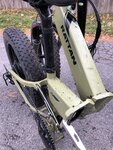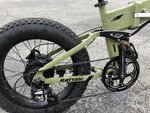ACF50 on all connectors far better than dielectric grease. Black RTV worked into any seams will help greatly.
Advice from a MN winter rider. Studded tires are best on spare rims, in my experience, dry roads are hard on the studs and very noisy. Best are the Norwegian Nokian brand tires, again in my experience.
What is it?
ACF-50 (Anti-Corrosion Formula) was originally designed to protect aircraft from existing and new corrosion and is now available to motorcyclists. Aviation products have to meet rigorously high standards and ACF-50 not only meets these but has been awarded Aviation approvals - MIL-SPEC 81309 types II and III which means it is 'approved for ferrous and non-ferrous metals, electrical systems and electronic components'. The US Navy carried out tests using ACF-50 on the jets on their Aircraft Carriers. They found that ACF-50 so significantly reduced the corrosion they had previously experienced they now use ACF-50 all the time!
It works perfectly in that type of harsh environment so imagine how well it's going to protect your bike!
When applied ACF-50 forms an 'Active' ultra-thin clear film that will kill any existing corrosion cells and will protect your bike against new corrosion forming. On areas such as switches or under the tank and seat, one application will last up to 12 months. Other more exposed areas will need topping up more regularly.
ACF-50 has the ability to 'chemically neutralise road salt' and water will bead on contact and literally bounce off. Ideal for the bike that is used all year round in all weathers, a superb service spray as ACF-50 is also a lubricant and penetrant (without loosening structural attachments) and if you put your bike away for the winter, applying ACF-50 will ensure that moisture will not be allowed to cause any damage! Untreated moisture will creep into cracks and will not freely evaporate - ACF-50 actively ejects moisture from these areas.
The Facts
- Kills existing corrosion and prevents new
- 'ACTIVE' for up to 12 months
- Excellent lubricant and penetrant
- Approved for use on electrics and engines
- Easily applied non-drying, ultra thin, clear film
- Very economical
- Contains no wax, silicon, Teflon or water
How to Use
ACF-50 is 95% product, hence virtually no propellant. Keep the tin in a warm environment, shake very well before use and remember a little ACF-50 goes a long way, so keep a rag handy to soak up any excess - then use the rag to help spread the product. ACF-50 has strong capillary action so will creep into all the areas that moisture can, 'actively' pushing out moisture and replacing it with protection. Go cautiously when applying to callipers to ENSURE YOU KEEP IT OFF THE BRAKES.
Use ACF-50 anywhere, except the brakes, on your bike including the engine and exhaust (will smoke on first start and burn off down pipes but still slows down corrosion process). Safe on paintwork, most rubbers and brings up black plastic trim a treat. ACF-50 contains no water and is approved for electrics so spray directly into electrical joints and components where it will prevent corrosion induced failures and high resistance joints. Works well at stopping dirt, mud and salt from sticking. You can come back from a winter ride with the bike 'white with salt' - a quick wash off and it's gone with the bike still protected.
Areas not in direct contact with the elements ie tank/seat areas, electrics require treating approx once a year. Other exposed areas re-apply as necessary. You can tell the product is still 'Active; as water will bead on contact...having no water content and not being water soluble ACF-50 only dissipates by being 'sacrificial' whilst stopping existing or new corrosion so just re-treat as required.
Remember, ACF-50 protects jets on US aircraft carriers! If it works for these jets in these conditions, think how well it's going to work for your bike!
What People are Saying about ACF-50
I ride a bike all year round and I have been using ACF-50 for about 18 months. My Hayabusa has not corroded and it is great on the wheels where all the road salt and grit ends up. All the alloy is corrosion free, and I will be using it straight away on my ZZR 1400 when I pick it up next week
Highly recommended
I 'discovered' ACF-50 last winter and was hoping that it was as good as the reports said. In November I gave the bike a thorough cleaning, took as many of the removable parts as possible off my BMW F800ST and gave it a good spraying. Snowy conditions aside, I commuted 300 miles per week and didn't wash the bike until the end of March. The bike was almost black. Guess what? Having removed all the layers of grime - no corrosion, the bike cleaned up like new. ACF-50 is amazing, all that's required is a strong nerve and a little faith!
1200.gs
“My mate ran this on his Fazer coated the engine, etc. Rode all winter in the wet, kept outside under a cover. Washed it off at the end of the winter, bike looked mint! Mine looked worse with only a handful of winter dry miles and garaged! Great stuff
I've used both: FS365 the winter before last and ACF50 this winter just gone. I prefer ACF50. "
Really good stuff! does what it says on the tin, would highly recommend this to anyone, bike's been fully protected with acf50 for two and a half years now with absolutely NO new corrosion or rust! well worth the money, wish i'd discovered it sooner!
lyn
Location: wild west wales!
The big disadvantage to FS365 is you have to keep re-applying it, especially after a wet ride. You get home, it's teeming down with rain and you have to spend a minute or two out there spraying the engine, fork legs, etc before you can cover it or roll it into the garage (assuming there's not enough room in your garage to do this).
With ACF50 you apply a nice coating and ... leave it. You can spray extra on occasionally, as you see fit. The engine looks absolutely filthy after a while, but that means its doing its job. I only cleaned the engine once or twice last winter, which meant reapplying the ACF afterwards, and it has survived fine. For the fork legs, I would clean and reapply every time I washed the bike.
It doesn't take much ACF50 to get a good coating so a can should last several winters, which makes it better value than FS365 in my opinion.”
"I was sceptical at first but I researched it on the net - It's used by the US Airforce on their aircraft carriers, used by boeing and other manufacturers. I have used it since September and apart from having to reapply it to my downpipes it has lasted through many washes and many winter rideouts, no furring on nuts and bolts or whatever. When you ride a 9 grand superbike it's worth its weight in gold. I have just replaced my tin having used it on my other vehicles. I paid 12 quid-ish. Despite the cold weather I have used my bike far more than before because I'm less anxious about road salt rotting my pride and joy!"
(MCN Website forum (allanr))
I am not a fanatical cleaner and polisher of bikes, I like them looking good but I also like riding them in the wet - bonkers I hear you say - not at all, it makes you a better rider and it tones your butt muscles!! Because of this I considered it prudent to try and give a helping hand to the shiny bits.
Metals such as steel and aluminium are inherently unstable and will corrode or oxidise over time in the presence of air and water. Add a dollop of road salt to the equation and you have yourself an electrolyte which, as the name suggests, is electrically conductive. This results in the formation of rust on steel or aluminium oxide, the grey powdery coating which we work so hard to polish off. So I purchased a can of ACF-50, the much lauded anti corrosion treatment originally produced for the aircraft industry by Canadian firm Lear Chemical Research, recommended by The Two Wheel Centre in Mansfield Woodhouse. Now it’s over 35 years since my Chemistry GCE but having read the techno blurb on the packaging, my understanding is it works by neutralising the electrical charge present by emulsifying the electrolyte. This prevents further corrosion on rusty or oxidised parts and stops the onset of corrosion on new parts, a bold claim but one which is backed up by plenty of testimonials on the web.
Application is either by spray directly onto the component or by cloth moistened in the fluid. My recommendation is a combination of both. As the manufacturer states on the bottle, the fluid disperses over quite large area so it is easy to be over enthusiastic. A word of warning, keep it well away from brake discs, tyres, footrest rubbers and handlebar grips as ACF-50 is also a pretty effective lubricant. I also recommend that you do the initial application over a weekend, first clean and dry the bike as normal then place plastic food bags on the footrests and handlebar grips.
Can in hand, carefully apply the fluid to all bolts, nuts, chrome plated parts, rear shocks, swinging arm, brake callipers, switchgear and underside of the bike. Leave overnight to allow the ACF-50 to creep into all the nooks and crannies. The following day wipe all the treated areas with the application cloth used previously to remove any excess and spread it further by wiping over the frame, fork legs, wheel rims and spokes. The only areas I didn’t apply it to were the tank, nose fairing and seat hump as these are waxed on a weekly basis.
If, like me, you prefer dry film or wax chain lubes which are great at reducing oil fling on to your shiny rear wheel due to their lack of oil based lubricants they can result in light rusting of the chain following a wet ride or two. My method is simple, grip the drive chain with a cloth moistened with ACF 50 and rotate the rear wheel which gives an even coating to the side plates and rollers. Apply your dry film chain lube immediately after and the chain will be rust resistant for a couple of months worth of wet riding
Be warned, when you crack up the motor for the first time following an application you will be greeted by copious amounts of white smoke billowing off any components which are subject to high heat! Spectacular but harmless. Only time will tell how good the product is.
Three months down the line and no sign of corrosion despite riding through the winter and all the torrential rain of late, not forgetting my penchant for power washing the bike at fortnightly intervals, sooner if needs be. I am a true believer in this product and would recommend it for use on any bike whether you ride in the wet on a regular basis or not.
Posted by: Blind Boy in Products ( Hosted on Hinckley Triumph)
CLICK HERE TO SEE A RECENT REVIEW OF ACF 50



